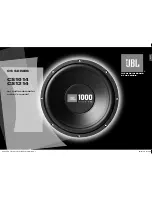
Ultra-X13 Owner’s Manual
Outlaw Audio
Ultra-X13 THX Ultra Powered Subwoofer
10
Scattered Subwoofer System
Why Two Subwoofers?
In most circumstances two subwoofers will
perform better than one. While you might assume
this is for added SPL, the greatest benefit will
actually be smoother bass response.
Room shape, the cubic volume of the room (width
x depth x height), furniture, floor coverings and
even wall and ceiling material all play a role in
bass performance. These factors create peaks
and dips in the level of low frequencies at different
points in the room. That said, two properly
positioned subwoofers will distribute the bass
throughout the room with greater accuracy than a
single sub. For this reason, many professional
acousticians and installers recommend more than
one subwoofer. The final result is that you will
create a much larger “sweet spot” where the bass
is powerful but more importantly smooth and
consistent. If near perfect bass response is your
goal, consider using two Ultra-X13’s for the
Outlaw Audio Scattered Subwoofer System.
What’s Needed to Connect Two Subwoofers?
Most of today’s digital receivers and pre-
amp/processors provide a single subwoofer
output. Connecting two subwoofers to these
systems is as simple as adding a Y-adapter. A Y-
adapter splits a single output into two separate
outputs. Be sure to use a Y-adapter that is of
equal or better quality than the subwoofer cables
you intend to use.
To use the Y-adapter, insert the single male end
of the cable to the subwoofer output of your
receiver or processor. On the opposite end of the
Y-adapter you will now have two separate
subwoofer outputs, one for each sub.
When using the XLR input on the Ultra-X13, you
may also connect a second subwoofer to the first
subwoofer using the Direct Pass-Thru output (I).
Placement and Level Control
Placement and level control of two subwoofers is
somewhat more complicated than using a single
subwoofer. However, the end result of two
properly placed and calibrated subwoofers is well
worth the added effort.
The procedure for placement of the second
subwoofer is identical to that of determining the
placement of the first subwoofer (see the
“Subwoofer Placement” section of this manual).
However, the second sub should be placed in the
seating area outside of the “sweet spot” where
good bass response is also required. Walk around
the room until you find the area where the bass
sounds the best, just as described in the process
for locating a single sub. This spot will almost
always be different than the one that was best for
the primary sub.
NOTE: When calibrating your second subwoofer,
be sure to turn off the first sub. This will help you
to determine ideal placement without being misled
by the response of the first sub.
When calibrating the final levels of each
subwoofer, you may want to reduce their output to
compensate for the added 3 or 4 dB of gain
created by using two subwoofers together.
If you sense a loss of bass output after properly
locating and calibrating both units in a two-
subwoofer system, the likely problem is that the
two units are out of phase with each other. If this
occurs try adjusting phase knob on the back of
one subwoofer at a time until the bass returns. For
more information regarding the phase control
function, please read the “Subwoofer Controls”
section of this manual.
































